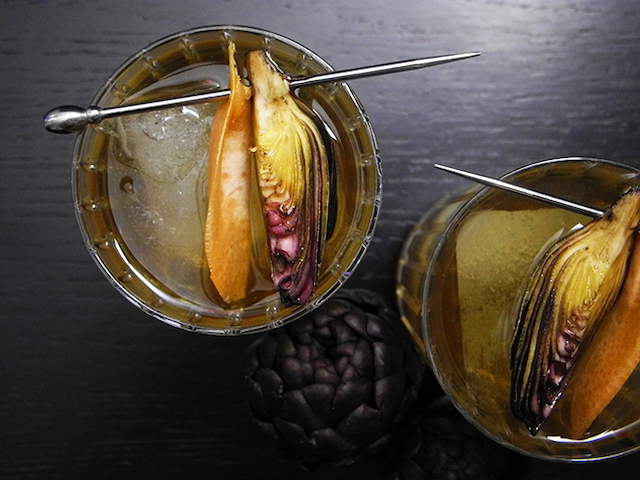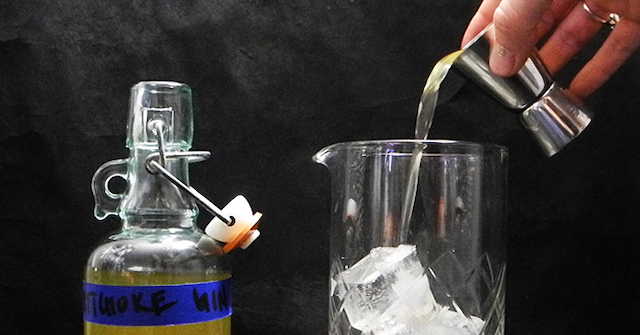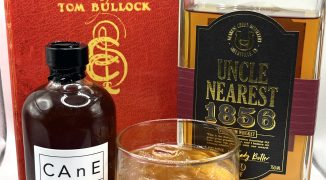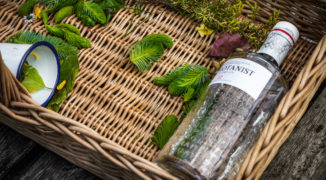You’ve done the fruit-infused vodka thing, cucumbered all the gins and fat-washed bourbon. Now what?
Typically, infusions are created using a neutral spirit such as vodka or gin and to play up the wood, caramel or honey notes in whiskey using fruits, herbs and fats. But, what happens when you infuse delicate spirits like vermouth or bold, complex spirits like cognac and Chartreuse, or work with unusual ingredients like artichokes and flowers?
Emily Arden Wells, the force behind the highly popular cocktail blog Gastronomista, is by day a New York City architect. But by night, Wells can be found in her kitchen creating structures of a liquid variety. Wells, an avid spirits infuser who loves to experiment with unusual ingredients in her cocktails, finds her inspiration comes from within the culinary world or the farmers market.
“A lot of my ideas simply come from walking through the grocery store and perusing the produce section,” she says. “I could be inspired by a particular dish I’m loving at the moment or by the aroma of a beautiful vegetable or flower I’ve found at the farmers market. Many flavors have already been developed by chefs, so bartenders may have to look no further than their back of house for inspiration.”
A stroll through the farmers market inspired one of Wells’ favorite cocktails, an Artichoke Negroni.
“A Negroni is one of my favorite cocktails. I found some baby artichokes one day at the market and began infusing them in gin. Cynar is produced using artichokes, so, I decided to build my Negroni with the infused gin to play up the artichoke flavor in the Cynar and then paired Cocchi Americano Bianco to cut the bitterness and lend that hint of sweetness.”
Wells began by quick-infusing gin and chopped baby artichokes in a sous vide for approximately an hour at 140 degrees. The sous vide allowed her to produce a gin which kept the freshness of the artichokes while still retaining the juniper notes of the gin.
 Gastronomista’s Artichoke Negroni sets the bar for what can be done with unusual infusions. Photo by Emily Arden Wells.
Gastronomista’s Artichoke Negroni sets the bar for what can be done with unusual infusions. Photo by Emily Arden Wells.
“Experimenting in the kitchen is a large part of how I create my infusions. I’ve done a Thai bird chili pepper-infused Green Chartreuse in a Last Word. The infusion of chilis to the Chartreuse added another layer to that drink but didn’t detract from it. I always have two bottles going with the chilis. One is the chartreuse, the other is Aperol. Chilis work beautifully in both spirits.”
One of the more unusual ingredients Wells has been working with lately are marigolds, which she had an abundance of over the summer. The aroma inspired her to research what could be done with the flowers, which are typically used for medicinal purposes as a cure-all for headaches, swelling and soothing burns, or as garnishes for salads, sugared candies or a substitute for saffron. Wells found marigolds are often used as infusing agents for tequila and mezcal in Mexico.
Kellie Thorn, beverage director at Empire State South in Atlanta, has mastered infusions with more complex spirits such as brandy and Cognac with simple ingredients like vanilla or black tea.
“Alcohol is very good at extracting flavors, so we often use infusions to add a layer or high note without adding volume to a cocktail, or in the case of fat-washing, to sometimes add texture and mouthfeel,” she tells us.
Thorn created the Death on the Moon, a brandy-based cocktail with absinthe and sparkling wine, by infusing the Austrian Pear Williams Purkhart with three to four high-quality vanilla beans. She splits and scrapes the beans, tossing the inner paste and bean pods into the bottle. The bottle is then stored in a cool, dark place for no more than three days, after which she strains its contents with a coffee filter. The brandy’s creamy texture and soft floral notes are enhanced with just a few beans.
Empire State South’s most popular cocktail, the cognac-based Two World Hero, is a riff on the classic Vieux Carre. Thorn produces a black tea-infused cognac using Pierre Ferrand 1840. She takes 25 grams of high-quality, loose leaf black tea and adds it to a 750-mL bottle for 10 minutes, allowing it to steep and then straining with a coffee filter. The cognac retains the floral notes but carries a touch of bitterness while punching up the tannic dark notes. She then pairs the cognac with a house made red wine syrup, rye whiskey, and Cocchi di Torino for a surprisingly potent yet very Southern version of the Vieux Carre that deceptively sips like sweet tea.
Miles Macquarrie, bartender and partner of Kimball House in Decatur, Georgia, says his infusions have more to do with the final product than the process. Like Wells, he’s inspired by the flavors he wishes to create for his cocktails based on the seasonal varietals found in the restaurant’s garden.
“We infuse a lot of spirits and use the spirit as a great mother for carrying additional flavor. Some infusions are very highly extracted in the form of tinctures and others are ways for us to preserve seasonal flavors.”
Thinking of your infusions as preservation methods allows you to a capture a seasonal moment in time. Macquarrie finds fortified wines and vermouths lend themselves well to garden-based infusions, as many of these spirits carry similar flavor notes he wishes to give extra attention to in his cocktails.
Infusing these fresh or fruit-forward spirits is part of the bar’s French-inspired aesthetic.
Georgia’s peach season has long been over, but Kimball House captured what has been a particularly strong season for peaches in the South in 48 bottles of infused blanc vermouth.
While you may not have access to a restaurant garden or maybe even a farmers market, the grocery store’s produce aisle is full of ingredients for infusion experimentation. If you’re stuck on how or what to create or unsure of a particular ingredient and spirit combination, Wells advises trolling both Instagram and cocktail menus for inspiration.
“The wonderful thing about the bartending community is their willingness to share ideas,” she says. “Search hashtags for infusions or ingredients you’re interested in on Instagram. Google will become your best friend. I’ve gotten ideas simply by reading cocktail menus and being like, ‘Oh! There’s a lemongrass-infused Campari,’ asking the bartender about it and then going back home to experiment. Don’t be afraid to ask a lot of questions. There’s nearly endless possibilities for creating really cool infusions for drinks.”
5 unusual infusions to try (and 5 cocktails to mix them in)
Artichoke-infused gin
- 3 mini artichokes, halved
- 2 c. gin
- Sous Vide Supreme
- Vacuum sealer
- Vacuum pouches
Seal in a vacuum pouch and submerge in the Sous Vide for 1 hour at 140 degrees Fahrenheit.
Pro Tip: Use the seal function only. Do not use the vacuum function when preparing liquids.
Chili-Infused Green Chartreuse
- 375 milliliter bottle of Green Chartreuse
- 5 Thai Bird chili peppers
Open a 375 ml bottle of Green Chartreuse and add 5 Thai Bird chili peppers. Let stand for a minimum of one week.
Chili-infused Triple Sec
- 375 milliliter bottle of Triple Sec
- 5 Thai Bird chili peppers
Open a 375 ml bottle of Triple Sec and add 5 Thai Bird chili peppers, and let stand for a minimum of one week occasionally testing the amount of spice. If it’s spicy enough, remove the peppers. If it needs more heat, add a few more peppers.
Black tea-infused Pierre Ferrand 1840 Cognac
- 25 grams of high-quality, loose leaf black tea
- 750 milliliter bottle of Pierre Ferrand 1840 Cognac
Infuse for 10 minutes (any longer, it becomes harsh.) Strain through a coffee filter.
Vanilla-infused Pear Williams Purkhart
- 3-4 high-quality vanilla beans
- Bottle of Pear Williams Purkhart Eau-de-Vie
Split and scrape three to four high-quality vanilla beans. Toss inner paste and bean pods into the bottle. Store in a cool dark place for two to three days. Strain through a coffee filter.





